Figures & data
Figure 1. Graphs depicting three patterns of enhancement curves typically seen in breast lesions, as intensity enhancement as a function of time. (a) type I–‘persistent enhancing’, (b) type II–‘plateau’ and (c) type III–‘wash-out’, with two different trends(solid and dotted line) both of which are encountered in LABC patients. The slope of the late enhancement (or wash-out) can be described with the wash-out parameter: WoP = ABS[(I10 − Imax)/(T10 − Tmax)] (see text).
![Figure 1. Graphs depicting three patterns of enhancement curves typically seen in breast lesions, as intensity enhancement as a function of time. (a) type I–‘persistent enhancing’, (b) type II–‘plateau’ and (c) type III–‘wash-out’, with two different trends(solid and dotted line) both of which are encountered in LABC patients. The slope of the late enhancement (or wash-out) can be described with the wash-out parameter: WoP = ABS[(I10 − Imax)/(T10 − Tmax)] (see text).](/cms/asset/bac5ef12-29ec-41a0-81c1-8b19ad149383/ihyt_a_402443_f0001_b.gif)
Figure 2. Neoadjuvant phaseI/II trial schema that was used at our institution for LABC patients between 2000 and 2004. The schema consisted of four cycles of paclitaxel, liposomal doxorubicin and HT (grey arrows) followed by surgery (bold arrow), with three dedicated MRI sessions (filled arrows) scheduled pre-cycle I, II and pre-surgery. The pre-therapy DCE-MRI set used in this study is circled on the time-line.
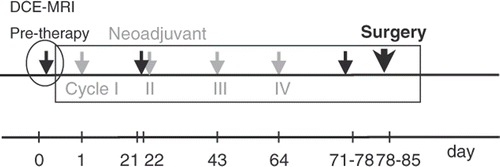
Table I. Components of the MPTS: the first component of the score is related to morphology and comes from the shape of the parametric maps. The second and third components are physiological, defined by the WiP and WoP. The ranges for the WiP and WoP were determined empirically from previous work. The MPTS is the sum score of the three components.
Figure 3. Sequence of DCE-MRI images taken before (time t = 0 min) and after bolus injection of the contrast agent Gd-DTPA for two different patients: (a) centrifugal enhancement, (b) centripetal enhancement.
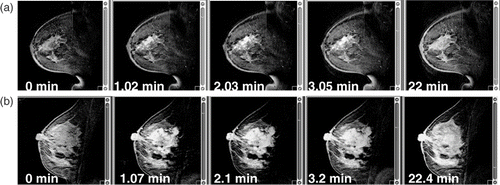
Figure 4. For the same two patients from : (A1, A2) fast-spin echo images; (B1, B2) subtraction images between the maximum enhancement time point and baseline; and (C1, C2) WiP maps.
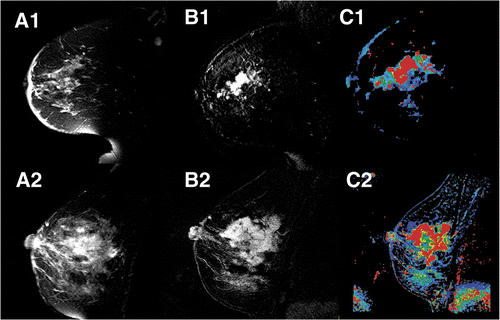
Figure 5. WiP maps generated from DCE-MRI that exemplify the type of enhancement noted in LABC patients: left column, centrifugal (CF), uniform enhancement from centre to periphery; right column, centripetal (CP), inhomogeneous ring-type enhancement.
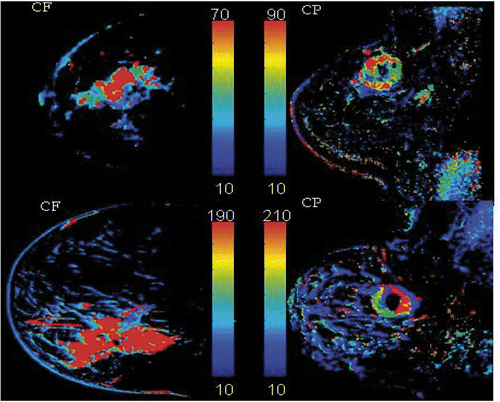
Figure 6. (a) Example of a 53-year-old patient (T4dNx at diagnosis) with a MPTS score of 6 who ultimately was a pathological complete responder (pT0N0). Shown here are the WiP parametric map with centrifugal morphology, and an enhancement curve with low WiP and WoP; (b) Example of a 64-year-old patient (T2N1 at diagnosis) with an MPTS score of 0 who was ultimately a pathological non-responder (pT2N1). The WiP parametric map shows centripetal morphology, and the WiP and WoP are high.
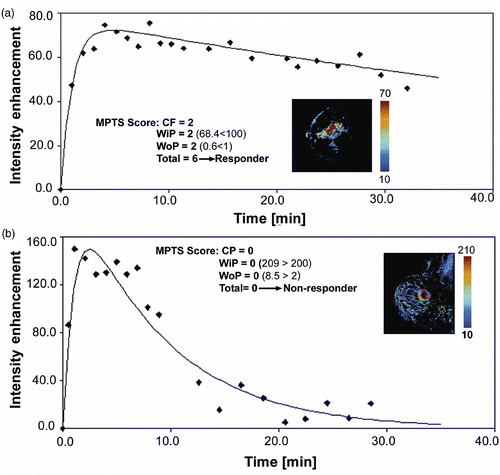
Table II. Maximum diameter per pre-therapy DCE-MRI in cm, post-treatment (TX) largest dimension per pathology in cm, MR-extracted parameters, enhancement pattern, WiP and WoP and the corresponding score, and the overall MPTS derived for each patient. The CEM43T90 and both the predicted response based on the MPTS and the actual pathological response are also listed. Patients are sorted by the MPTS score from highest to lowest.
Table III. Summary of MPTS for the 20 patients evaluated in this study. Of the patients with a score in the 2–6 range, 10 out of 12 (83%, 95% CI: 52%–98%) were responders. Of the patients with a score between 0 and 1, 1 out of 8 (13%, 95% CI: 0.3%–53%) was a responder.